“Creatures of the dawn: How radioactivity unlocked deep time”, BBC Future
By Thomas Moynihan, Deep Civilization, London, 29th September, 2021
When scientists discovered the energy embedded within atoms, it transformed how we think about the long-term future of humanity, writes the historian Thomas Moynihan.
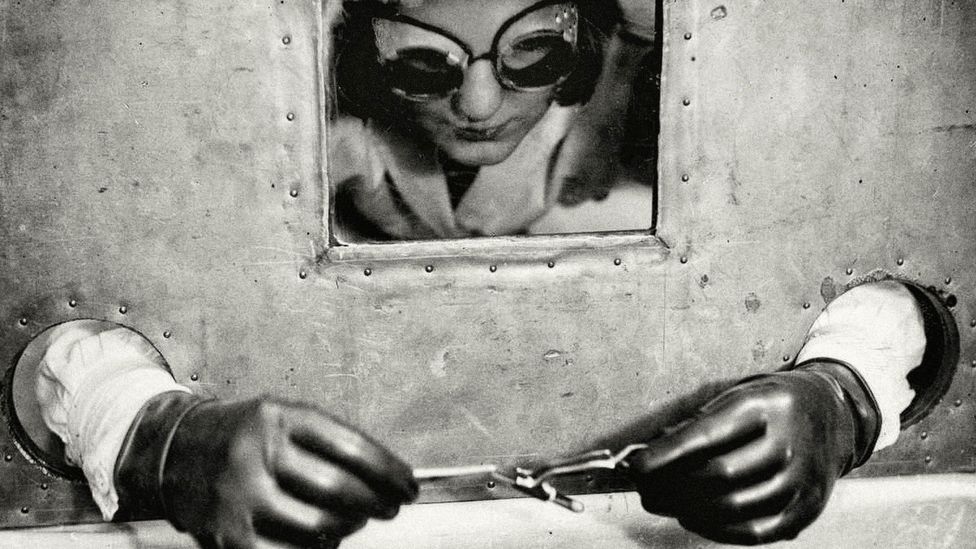
Just over 100 years ago, an ocean liner – twin to the Titanic – returned to Normandy from the US with a very special item. It was a summer’s day in 1921, and travelling on board was the scientist Marie Sklodowska-Curie, accompanied by her daughters, Irène and Ève. In their possession was a single gram (0.04oz) of radium, locked away in a lead box within the ship’s safe. In today’s money, it would be worth $1,500,000.
It had been presented to her by none other than the US president. But it was purchased with donations from thousands of American women, following a fundraising initiative kickstarted by journalist Marie Meloney.
Curie had secured celebrity by unleashing the theory of radioactivity upon the world, revealing for the first time the atom’s innards: the microcosm of activity, and cornucopia of energy, within. She had discovered new radioactive elements, the most famous of which was radium. For this, she won her first Nobel Prize.
We all know how nuclear physics went on to alter our world forever. The gram gifted to Curie helped further research on the atom that, ultimately, led to the development of nuclear weapons. What is less known, however, is that – decades before the bomb – radioactivity had already revolutionised our world in ways that were just as profound, if more subtle.
Eclipsed by the infamy of atomic warfare, this is the near-forgotten story of how radium forever transformed attitudes to time and where we may be within history – creating the first efflorescence of truly long-term thinking. Until that point, we knew the Earth was old, but hadn’t fully embraced how many more millions – or even billions – of years could lie ahead for humanity and the planet.
Appropriately, Curie came away from the US exhausted but with a conviction of “unlimited possibilities for the future”.

Marie Sklodowska-Curie (seated) with her daughters Irene and Eve and Marie Meloney (centre), on RMS Olympic in 1921 (Credit: Getty Images)
Our sense of where we are in history rests on our sense of how much future history we expect is left ahead. In Europe, for generations, Christians assumed they were much closer to time’s end than its beginning. Judgement Day was anticipated soon.
The first scientific treatments on the matter, based on extrapolations of physical process rather than scriptural prophecy, emerged in the 1700s. Naturalists began attempting to forecast how long Earth would remain habitable.
People also began realising that, compared to the geological past, humanity had not existed very long – civilisation even less so. In this context, it became sensible to suggest everything humanly achievable had perhaps not already been achieved. The future became a canvas for hope. Optimists suggested our species could continue inquiring, inventing, improving until the Earth becomes uninhabitable.
You may also like:
- BBC Future’s Deep Civilisation season
- The long-term quest to build a galactic civilisation
- The benefits of embracing deep time
The problem was that, by Victorian times, science’s judgement on how much future lay ahead was somewhat austere. Physicists had started calculating how long the Sun could continue to shine for, but because they falsely believed that it generates heat by collapsing under its own weight, their estimates were far too short.
In 1854, it was forecast by Scottish mathematician Lord Kelvin that there were only 300,000 years left. After this, he declared, Earth will be sterilised by cold. Estimates on the deadline varied between physicists, but by the century’s closing decades the community converged upon the very low tens of millions.
For many thinkers of the period, it was the ratio of “time ahead”, to “time spent”, that proved particularly depressing. Expressing the general mood in 1893, one Irish astronomer pronounced that our “Sun had already dissipated about four-fifths of the energy with which it may have originally been endowed”. Evolution had come thus far; it didn’t have time to go much further.
As the 1800s closed, there was little room for grand optimism regarding humanity’s far-flung future on Earth.
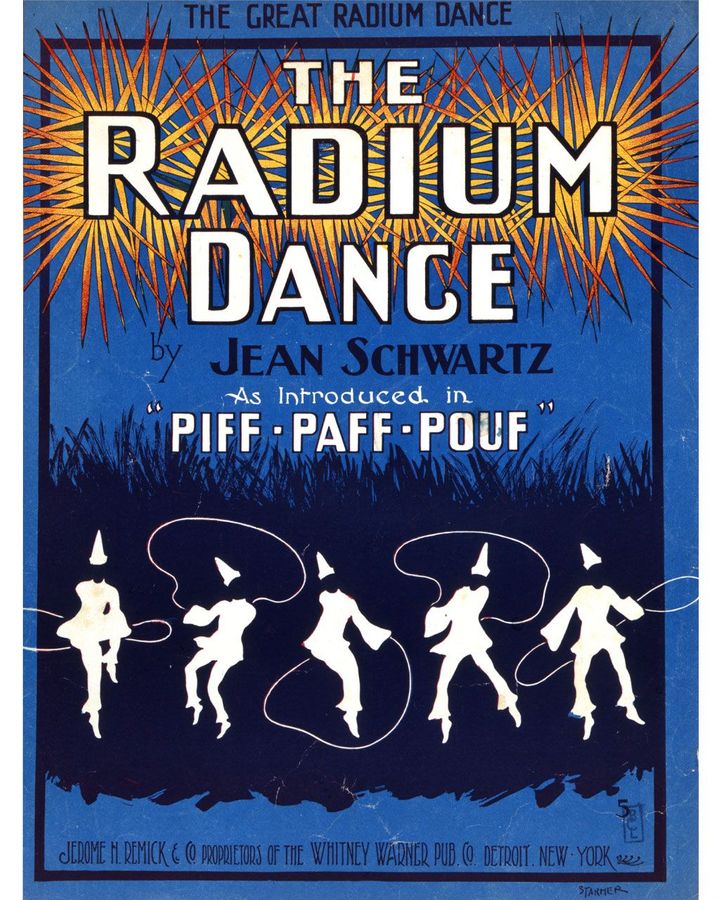
As the 1900s dawned, “radio-mania” captivated culture, inspiring music and consumer products (Credit: Getty Images)
Then, the 1900s dawned, and radioactivity was discovered. This changed everything.
In March 1903, the Curies demonstrated that radium continuously emanates a surprising amount of heat. This came from inside radium’s own atoms, rather than from exchange with its surroundings. Radioactive atoms were furnaces.
Measures of the amount of energy within atoms were shocking. Previously considered indestructible, this wealth was being gradually disbursed asthe atom itself disintegrated – sometimes over billions of years. Perhaps the most evocative example of this long, atomic reach into the future was a clock made in 1903, powered by radium: it was projected to keep “ticking” for millennia.
These revelations triggered a flurry of excited responses from scientists. Within months, an astronomer suggested that radioactivity may “afford a clue to the source of energy in the Sun”. Another celebrated Curie’s “unexpected” discovery of this “new source of energy”: suggesting that, if the Sun powers itself by “liberating atomic energy” – rather than languorously collapsing –then we will have to extend the “cosmical time-scale” by several factors.
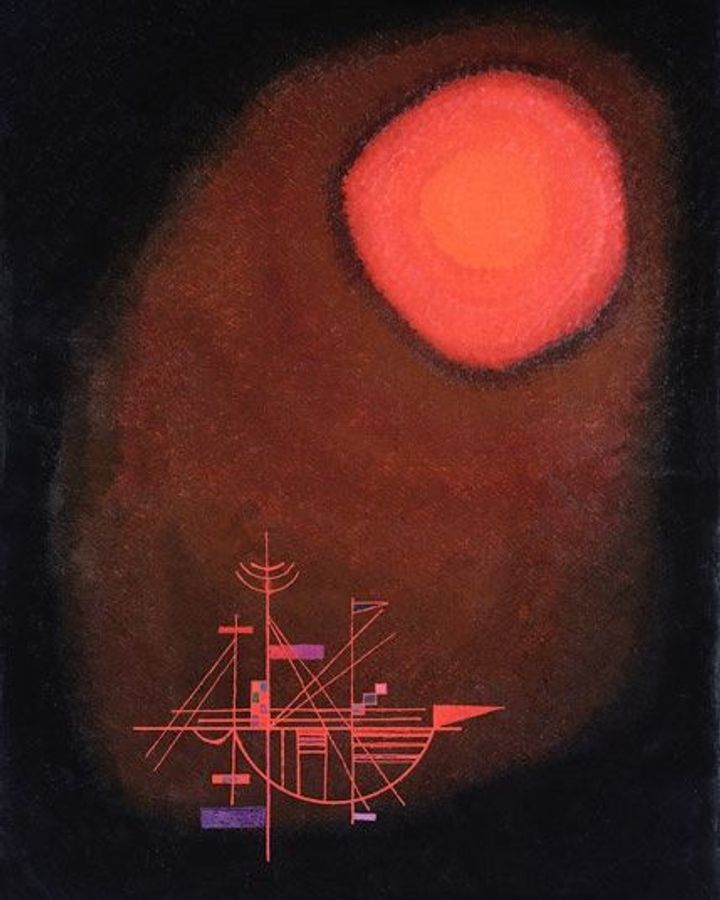
Wassily Kandinsky’s Ship & Red Sun. In 1913, the artist remarked the discovery of disintegrating atoms made “everything precarious, unsteady, pliant” (Credit: Kandinsky)
The UK newspaper The Daily Mail swiftly ran an article in response. “Radium to the Rescue”, it boldly relayed: from meagre millions, Earth’s habitable future had just swollen by “several hundred million years”. By 1920, experts were granting “15 billion years” of further sunlight.
Having grown up believing Earth was “plunging on” to “final winter in the near future”, scientists welcomed the discovery of these little “atomic stoves” – within the heart of matter – which could seemingly fuel our world for orders of magnitude longer. No longer can we believe “ours is a decadent Sun”, with the “red-yellow tinge” of solar senility, one journalist exclaimed: radium had come “to the rescue”, extending “indefinitely the backward and forward sweep of the cosmical timetable”.
During the 1920s, estimates on the future continued to expand. One prominent physicist, James Jeans – describing atoms as “pure bottled energy” – boldly estimated our Sun retains enough “unbroken bottles” for a whopping trillion years more sunlight. While this later proved excessive – its expected lifespan was slashed to 5 billion years in the 1960s – it speaks to just how far the horizons of the time were expanding.
Communicating the potential scale of the future to the public in 1929, Jeans visualised a stamp atop a penny, balanced upon a 20m-high (66ft) obelisk. The stamp’s thickness represented. recorded history. The stamp and penny combined represented our species’ existence. The distance from the stamp down to the obelisk-base was the age of Earth.
Jeans didn’t stop there. He calculated the height of postage stamps, stacked one atop the other, you’d need for a trillion further years of habitability on Earth. “A pile as high as Mont Blanc”, he concluded.
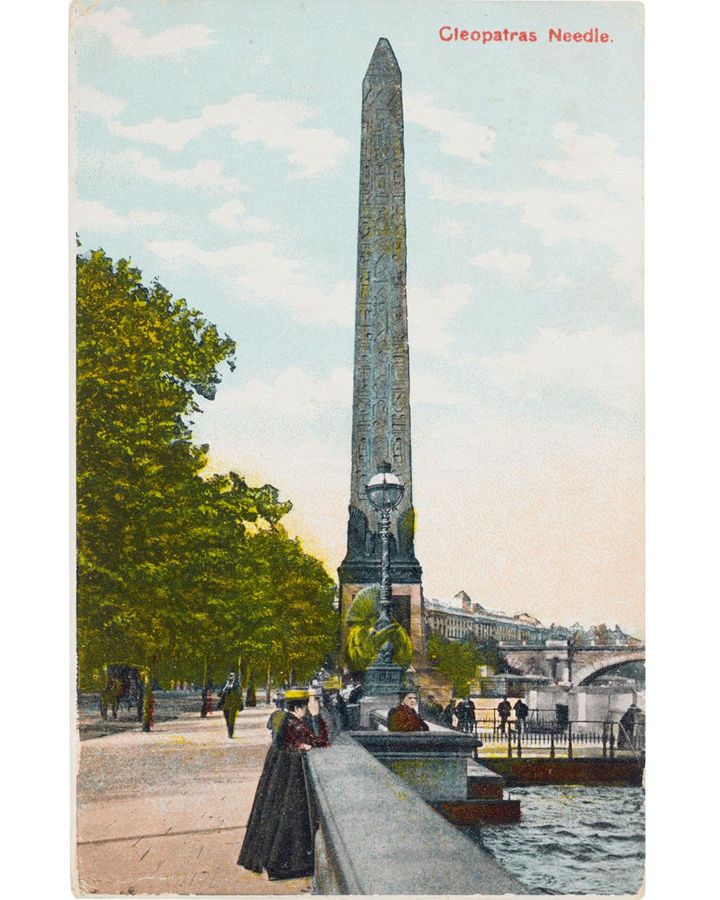
A postcard depicting Cleopatra’s Needle, just over 20m (66ft) tall, gifted to the UK in 1819 (Credit: Alamy)
Jeans deemed us “creatures of the dawn”, with “unimaginable opportunities for accomplishment” and “unexplored potentialities” ahead.
Others would reach similar conclusions. Geologists concurred that “Homo sapiens is still a youthful species”. And radiochemists celebrated a “profound reversal of mental outlook”: from a sense that the pinnacles of achievement lay in some past “Golden Age”, physics now suggested they may lie within the roomy future.
In sum, Curie’s discoveries completely inverted the ratio of expected future to established past. From thinking they lived near history’s end, people now recognised they could be living during its very beginning. Humanity’s universe, no longer decrepit, now seemed positively youthful.
Jeans deemed us “creatures of the dawn”, with “unimaginable opportunities for accomplishment” and “unexplored potentialities” ahead
Compared to the “cosmical” past, it appeared Homo sapiens had emerged only in the latest splinter of time. Serious, scientific attempts to improve the species’ material conditions had only just emerged within a splinter of that splinter.
Given all this, geologists claimed that, if we suppose humanity unique in its capability to respond to moral reasoning, then (extremely fallible though this faculty of ours evidently remains) the epoch of ethical agency on Earth may only just be dawning.
The generous prospect ahead “becomes almost stupefying”, one writer rhapsodised in 1921, “if we pay attention to the modern rate of progress”. We can but “dimly conceive” what might be accomplished in the eons ahead, if the “rate we are going” continues to be even minimally retained.
After radium’s revelations, Jeans explained that the message of physics was one “of responsibility, because we are drawing plans and laying foundations for a longer future than we can well imagine”.
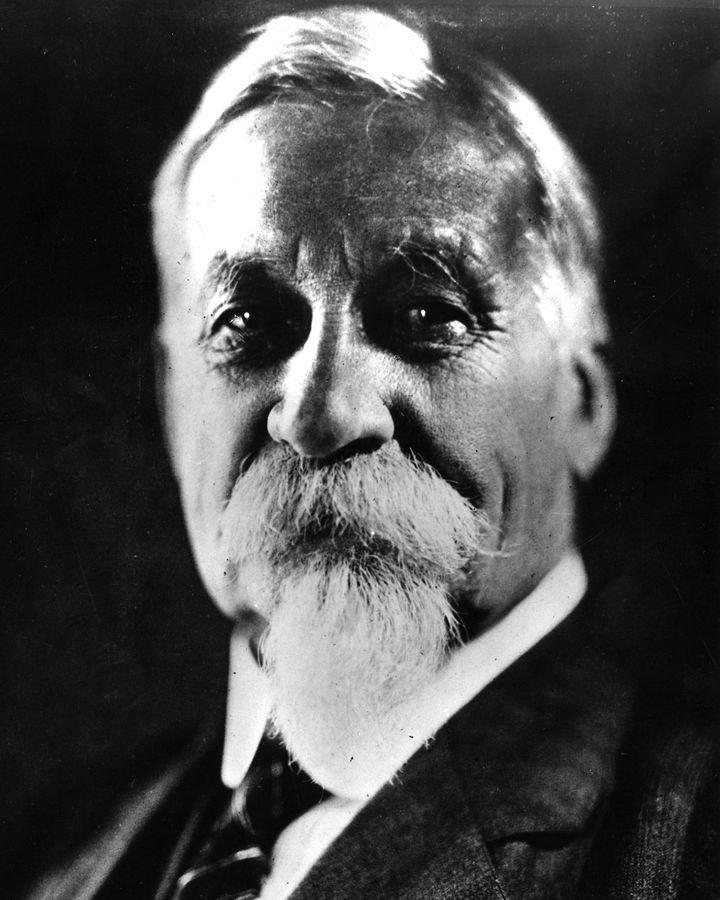
Thomas Chrowder Chamberlin had a beard as prodigious as the glacial drifts he studied (Credit: Getty Images)
In September 1928, these new responsibilities to humanity’s deep future were presciently articulated by the geologist Thomas Chrowder Chamberlin, two months before he died.
When a journalist interviewed him in his Chicago study, Chamberlin gave a crinkled smile and said he was “a declared believer in large opportunity” for humanity.
Chamberlin pointed to the fact that humanity had only just discovered the “enormous energies” corked up in atoms. “So I think we are really just in the beginning of things, just beginning to learn how to think”. Our speciesis like an infant, he continued. “From the standpoint of the Earth, I am an advocate of a great future”.
More than most, he had already pondered the ethical implications of a ballooning future. Across a 60-year career, he had pioneered theories about climate change: proposing, in 1899, that CO2 causes global warming. He even suggested human activities are altering Earth’s future climate. This demands “altruistic purpose”, in regulating present “action”, to safeguard “generations that may live tens of thousands of years hence”.
And in June 1898 – a month before Curie glacial introduced the term radio-activité – Chamberlin was asserting that our ignorance regarding subatomic processes means that we should be suspicious of Kelvin’s estimates of a meagre future.
When advances in nuclear physics rapidly proved him right on his bullish predictions for Earth’s prospects, he began insisting that the expanding future demands heightening responsibility.
By 1903, he was, on these grounds, claiming that the best actions are those that – compounding over time – snowball into “great things” in the “long ages” ahead.
The “protracted influence” of altruistic actions, rippling forward through eons, amplifies their positive “contribution”. But, by the same token, the same applies to the “ulterior” impact of damaging actions. Prudence therefore demands being mindful of our usage of Earth’s finite “resources”, he sagely suggested.
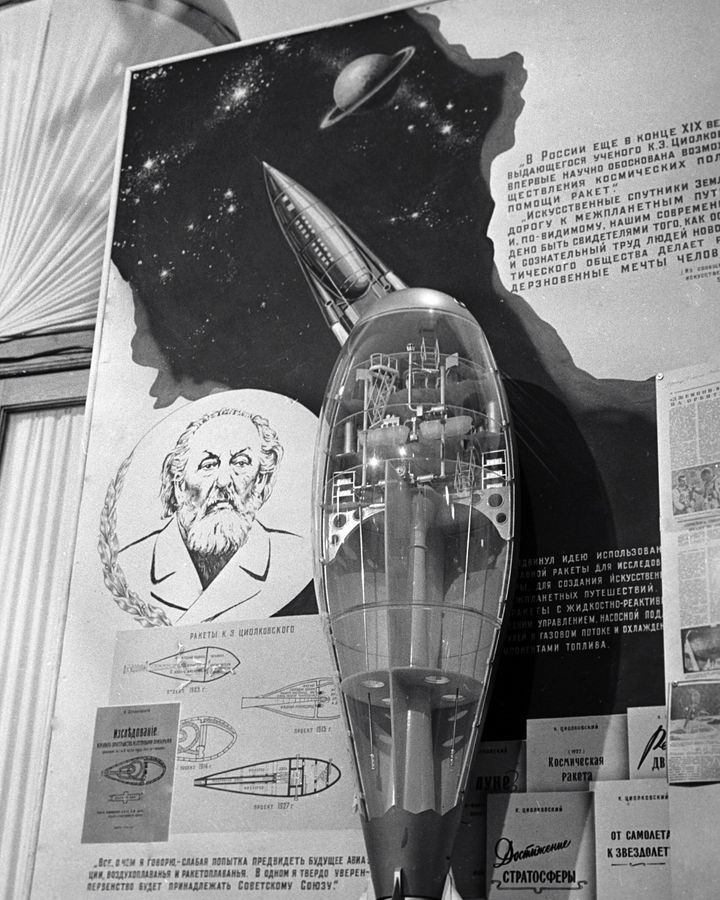
A model for a rocket, following Konstantin Tsiolkovsky’s blueprints (Credit: Alamy)
Meanwhile, the discovery of radium was expanding perspectives of humanity’s place in the Universe in other ways: it also promised new methods to catapult civilisationoff-world.
Prior physics came with a low ceiling on future time – and the same applied to assumptions of available energy. But here, in mundane matter – of which we are all awash in abundance – were revealed energetic coffers “of a magnitude of which we have no experience”. So wrote Frederick Soddy, co-discoverer of radioactive decay. “The energy is there. The knowledge that can utilise is not – not yet”.
Though migrations within our Solar System had been envisaged before, it’s hard to find people anticipating crewed travel to other stars before 1900. But, by revealing generous headroom in expected future and untapped energy, nuclear physics made interstellar travel suddenly seem feasible… at least, eventually.
The biochemist J.B.S. Haldane claimed that, if it became star-hopping, civilisation could last for 80,000,000,000,000 years
The visionary Russian engineer, Konstantin Tsiolkovsky, was the first to put all this together. In 1911, he stated that, if you could tap the energy within radium, then you could propel a rocket to the nearest sun within 10-40 years.
What’s important here is that achieving interstellar exodus would uncouple the lifespan of humanity from the lifespan of our Sun, exploding the ceiling on the size of humanity’s future once again.
“A pinch of radium would be enough for a ton rocket to sever all ties with the Solar System”, Tsiolkovsky surmised. Humanity could then migrate “from Sun to Sun”, persisting for cosmological timescales.
By 1927, the biochemist J.B.S. Haldane claimed that, if it became star-hopping, civilisation could last for the lifespan of the entire galaxy. He guesstimated that this could be 80,000,000,000,000 years.
“And there are other galaxies”, he piquantly added.
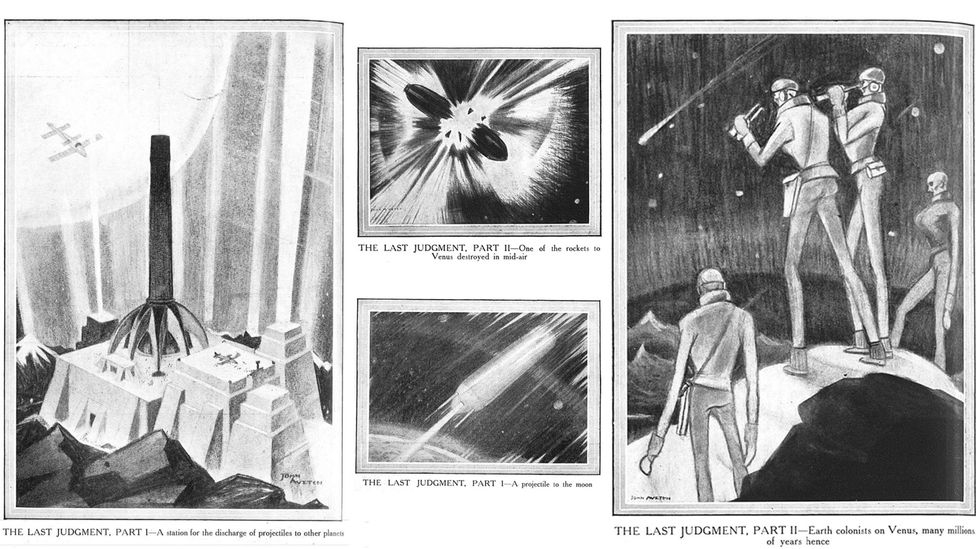
Illustrations from Haldane’s short story “The Last Judgment”, in The Graphic, Saturday 26, February, 1927 (Credit: John Archibald Austen)
A voluminous future for galactic humanity beckoned. But, as Chamberlin acknowledged, possibility and “opportunity” doesn’t “ensure actual realization”. Jeans, likewise, warned that “accident may replace our Mont Blanc of postage-stamps by a truncated column of only a fraction…”
As one journalist asked at the time: we may “paint optimistic pictures of the future on the hazy horizon of the million years ahead”, but what of the potential for mishaps that may extinguish humanity, cancelling our “alluring hopes of progress” and the “world-picture of coming grandeur”? There may indeed be “almost infinite possibilities of betterment”, he wrote, but this only deepens the tragedy of lost potential should humanity somehow go prematurely extinct “within the next thousand years, the approaching century, or even on a succeeding day”.
Scientists were confident that the risks from nature were comfortingly low. The same, unfortunately, could not quite be guaranteed for the potential perils posed by humanity’s own inventiveness. Ever since 1903, there had been recurrent fears – in both the press and scientific literature – that uncorking an atom might ignite the Earth “like a barrel of powder”. Some suggested that, if the Earth is packed with radioactive ores, then we live upon a “storehouse stuffed with explosives”: tampering with atoms might trigger a cascading reaction, immolating our planet.
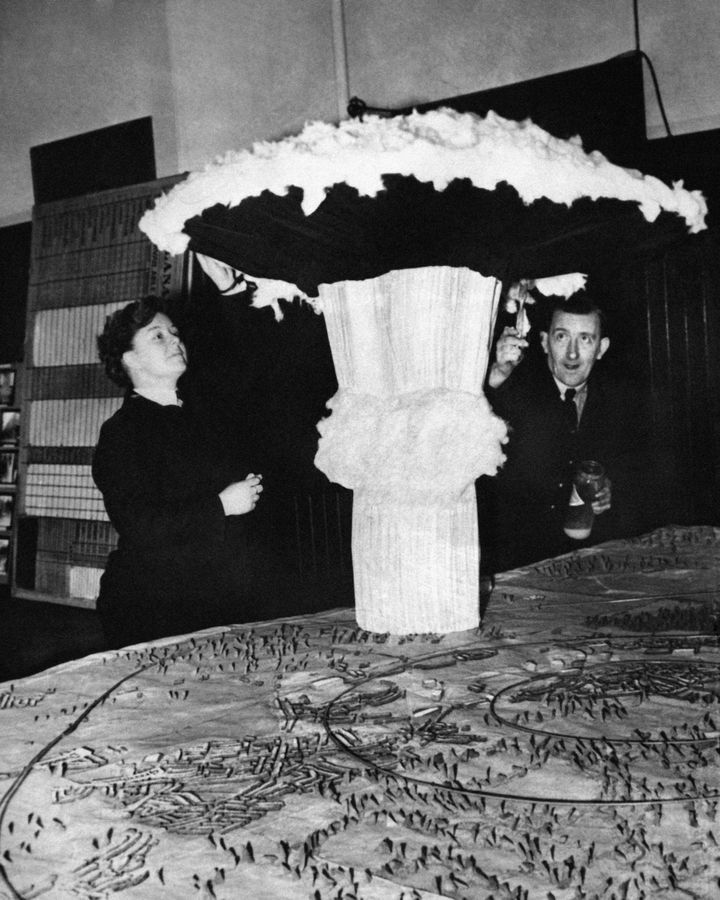
Before the atomic bomb was developed, people also worried that we’d accidentally trigger a catastrophic nuclear reaction within the Earth (Credit: Getty Images)
In 1924, one melodramatic engineer, at Sheffield University, caused panic with boasts that he was about to successfully smash an atom. Sensationally, newspapers reported that this might detonate the planet. He received terrified letters from the British public, begging him not to complete his experiment.
No such “cosmocataclysm” happened, of course. Atomic tinkering didn’t ignite the Earth or turn our planet into a new star. But serious discussions were had, for the first time, assessing whether humanity may soon pose a greater risk to itself – through accumulated technological might – than threats from nature. Suggestions that have since become darkly true. After developing thermonuclear weapons in the 1950s, humanity began to emulate the subatomic processes within suns successfully enough to destroy itself and its extended future.
The irony is that the nuclear discoveries – kickstarted by Curie – that have latterly put that future in jeopardy were precisely the same ones that first brought a spacious future, with vast potentials, into view.
Insights for today
There are important lessons here for those seeking to take a long-term view in the present day. First, be cautious claiming “never” with anticipated technological breakthroughs, particularly when the consequences of their invention may change the course of civilisation forever. A century ago, prominent physicists maintained that unbottling atoms was definitively impossible. One, in 1930, dismissed the “hobgoblin” of nuclear energy as “myth”. He advised everyone “sleep in peace”, knowing God has put child-locks on his “handiwork”, such that humanity cannot disturb the universe. Eight years later, nuclear fission was unlocked by Lise Meitner.
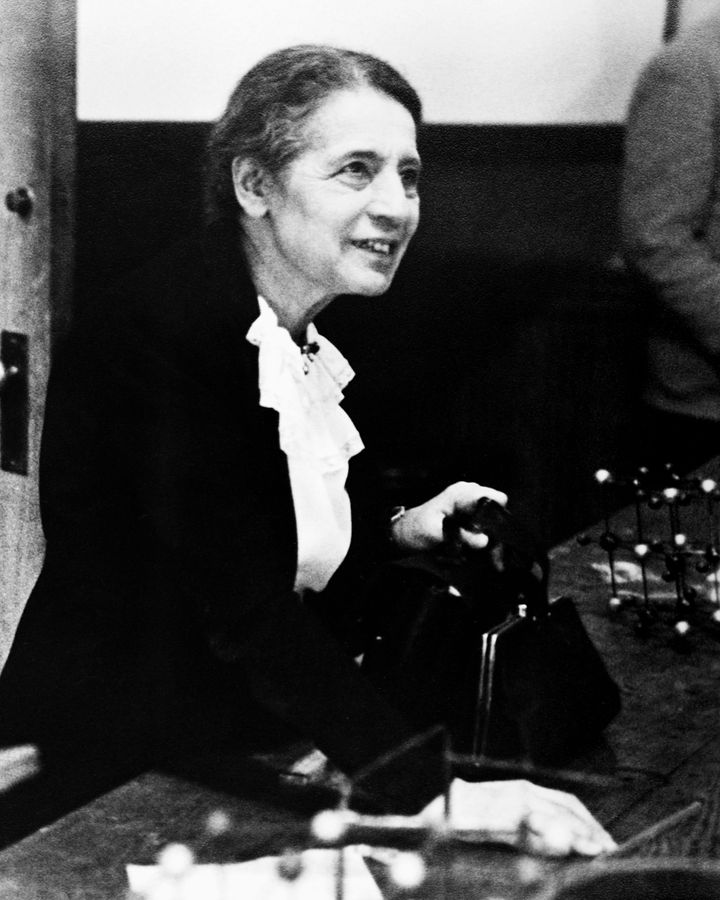
Despite predictions to the contrary only years earlier, Lise Meitner would unlock nuclear fission (Credit: Getty Images)
Second, predicting timelines on such breakthroughs is difficult. Writing on humanity’s long-run future in 1927, Haldane (amongst the most skilled forecasters of his generation) thought it sensible to portray return trips from the Moon as eluding humanity until AD8,000,000. This feat was accomplished, by Apollo 11, just 42 years later.
Soddy, writing in 1919, warned that, once people discover how to weaponise isotopes, unprecedented destructive potential will be unleashed. All he could do was hope “this discovery will not be made” until humanity has the prudence not to misuse it.
Haldane’s prediction, and Soddy’s hope, proved misguided. The point here is that we, exactly a century later, stand in an identical position with regards to various new emerging technologies, from artificial intelligence to synthetic biology, which could imperil our entire future. For example, it seems plausible that engineering deadly pathogens will only become cheaper and easier, but we do not know how long it will take before it becomes easy enough to pose a serious threat to everyone.
We need more than “hope” that we tackle the challenges promised by oncoming technologies before they are unlocked and unleashed. As happened with atomic power, world-changing technologies can be developed sooner than experts expect, so it pays to be prepared rather than complacent.
Equipped with better understanding of how the Sun will age, and how sensitive Earth’s climate will be to its aging, today’s predictions on future habitability have decreased from the trillion years forecast by Jeans. Many scientists now predict something under 1 billion years left for complex Earth-bound life. However, balancing this, nothing has yet been found – in heavens nor Earth – to imply that humanity cannot achieve interstellar diaspora before this time. And estimates on how long the wider Universe may remain capable of supporting complex life are truly eye-watering.

“Dawn”, by Joseph Farquharson, painted in 1903: the year Marie Curie won her Nobel Prize for discovering radium (Credit: Joseph Farquharson)
Humanity’s future could be astronomically large, as scientists in the early 1900s first noticed. It could be commodious enough to make some reparation for all the frustrated, snatched, and wasted opportunities of history so far. The most impactful and resonant actions, then, might be those that target safeguarding this long-term prospect. Yet right now, humanity remains like an adolescent: irresponsible, albeit first waking up to the fact that actions can have irreversible, reverberating consequences.
Probably the first “longtermist“, Thomas Chamberlin said it best in 1910: “The highest conception of altruism which I am able to form is built on the thought of doing things that are sound enough [to] last and be doing good ages after they have lost the name and superscription of those who set them going.”
*Thomas Moynihan is the author of X-Risk: How Humanity Discovered Its Own Extinction and a research fellow at Forethought Foundation and St Benet’s College, Oxford University. He tweets at @nemocentric and can be found at www.thomasmoynihan.xyz.